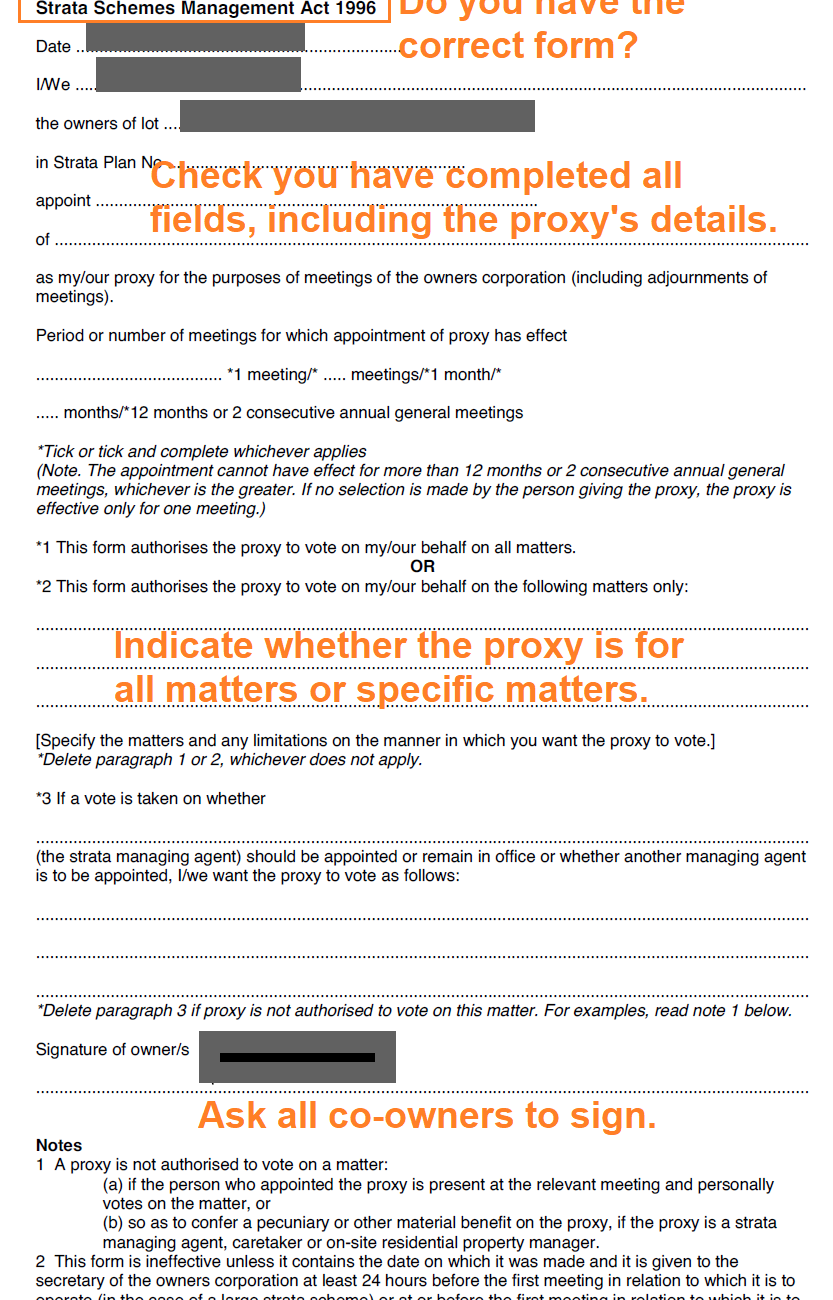If you own a strata property, it is important to stay informed of any financial and legal matters that require agreement from the majority of the owners (more than 50% of the owners). Every year, the annual general meeting is your opportunity to have a say on essential matters concerning your strata’s by-laws, finances, insurance and electing the strata committee members who will make decision on your behalf.
If you are unable to attend a general meeting, you can nominate someone to attend and vote on your behalf so that your vote can still count. Be sure to follow the following tips when you complete a proxy form.
1. Use the correct form
If your state or territory mandates a specific proxy form to use, check you have the correct one before you complete the form. In NSW, this is the current proxy form as prescribed in the Strata Schemes Management Regulation 2016. If you are unsure, contact your strata manager or the relevant government authority in your state or territory.
Visit the following government examples for a template form:
New South Wales: see NSW Fair Trading
Queensland: see Department of Justice and Attorney-General
Victoria: See Consumer Affairs Victoria
2. Ask all co-owners to sign a proxy
To be absolutely safe, you are best to ask your appointor if there is more than one owner and if so, could they also sign the proxy form.
The issue of whether all co-owners need to sign a proxy was raised in Babray & Ors v Whittles Australia Pty Ltd (Owners Corporations) [2013] VCAT 327. In this case, the validity of a proxy form was questioned as it was signed only by one of the two co-owners. However, the court did not decide on this issue as the proxy form in question was accepted at the strata committee meeting. At the same time, the court did state its preference that all co-owners to sign the proxy form so that it is clear that their joint vote may be exercised by the appointed proxy.
3. Indicate whether all matters or specific matters
Remember to check with the owner you are approaching whether they prefer that you represent them in all matters or specific matters. For example, the voting instructions could be as specific as changing a by-law in relation to hanging laundry items on the balcony.
What happens if the voting instructions are unclear? In Thoo v The Owners Strata Plan No. 50276 [2011] NSWSC 657, the appointor did not select either of the two options (all matters or specific matters) and consequently the court found the failure to record the voting instructions invalidated the proxy.
4. Complete all applicable fields
An incomplete but signed proxy form like the one below not only jeopardises its validity, it may also fall into the wrong hands for the proxy to be exercised against the appointor’s original intention.

We came across this proxy when it was distributed in an online chat group and every person in the group could view, download and use the form at their discretion.
On the left is an example of an incomplete proxy form (with the completed fields redacted), signed and distributed in an online chat group for a strata complex.
5. Appoint an alternative proxy
The appointor may nominate an alternate proxy if the main proxy is likely to exceed the number of proxies they may hold. The maximum number of proxies one can hold may depend on the strata laws in your state or territory.
While you can nominate anyone to be your alternative proxy, it is a good idea to tell your alternative proxy how to vote if they are unfamiliar with your strata or are not affected by the decisions being made, before the meeting.
If you have any questions about living in or buying a strata property, contact us on 0402 990 108 or email us today.

Comments are closed